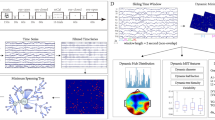Abstract
We have analyzed the interdependencies between different regions of human brain during processing of different kinds of music by using multivariate EEG signals. In this study, a recent index, called similarity index, SI was used, which unlike the traditional linear measures is able to provide information about the direction of the interdependency. Relatively active and passive regions of the brain were highlighted, where the measure of the activity was reflected by the excited degrees of freedom at a typical length scale. The SIs during each task were compared statistically and significant changes (p ≤ 0.05) were depicted in schematic maps of the brain. A topographical representation of the S.I. showed differences in the connectivity while listening to different pieces of music.
Access this chapter
Tax calculation will be finalised at checkout
Purchases are for personal use only
Preview
Unable to display preview. Download preview PDF.
Similar content being viewed by others
Bibliography
Shaw, G.L., Kee** Mozart in Mind (Academic Press, San Diego, 2000).
Sergent, J. (1993) Hum. Brain. Mapp. 1, pp. 20–38.
Bradshaw, J.L., & Nettleton, N.C. (1981) Behav. Brain. Sci. 4, pp. 51–91.
Chauvel, C.-L., Peretz, I., Babar, M., Laguitton, V., & Chauvel, P. (1998) Brain 121, pp. 1853–1867.
Tononi, G., & Edelman, M. (1998) Science 282, pp. 1846–1851.
Sarnthein, J., Petsche, H., Rappelsberger, P., Shaw, G.L., & von Stein, A. (1998) Proc. Natl. Acad. Sci. USA 95, pp. 7092–7096.
Priestly, M.B. (1981) Spectral Analysis and Time Series (Academic Press, London).
Bullock, T.H., & McClune, M.C. (1989) Electroencephal. Clin. Neuro-physiol. 73, pp. 479–498.
Petsche, H., & Etlinger, S.C. (1998) EEG and Thinking (Verlag der Österreichschen Akademie der Wissenschaften, Wien, 1998).
Lopes da Silva, F.H., Piijn, J.P., & Boei**ga, P. (1989) Brain Topogr. 2, pp. 9–18.
Eckmann, J.P., & Ruelle, D. (1985) Rev. Mod. Phys. 57, pp. 617–656.
Pecora, L.M., & Carroll, T.L. (1990) Phys. Rev. Lett. 64, 821–823.
Rulkov, N., Suschik, M.M., Tsimiring, L.S., & Abarbanel, H.D.I. (1995) Phys. Rev. E 51, 980–994.
Arnhold, J., Grassberger, P., Lehnertz, K., & Elger, C.E. (1999) Physica D 134, 419–430.
Sauer T., Yorke, J. A., & Casdagli, M. (1991) J. Stat. Phys. 65, 579–616.
Bhattacharya J., Pereda, E., Petsche, H. (2001) J. Neurosci. 21, 6329–6337.
Schiff, S.J., So, P., Chang, T., Burke, R.E., & Sauer, T. (1996) Phys. Rev. E 54, 6708–6724.
Van Quyen, M.L., martinerie, J., Adam, C., & Varela, F.J. (1999) Physica D 127, 250–266.
Kantz, H., & Schreiber, T. (1997) Nonlinear Time Series Analysis (Cambridge University Press, UK).
Casdagli, M., Eubank, S., Farmer, JD., & Gibson, J. (1991) Physica D 51, pp. 52–98.
Theiler, J. (1986) Phys. Rev. A 34, pp. 2427–2432.
Abeles, M. (1991) Corticonics-Neural Circuits of the Cerebral Cortex (Cambridge University Press, Cambridge).
Badii, R. et al. (1988) Phys. Rev. Lett. 60, pp. 979–982.
Bullock, T. H. (1997) Proc. Natl. Acad. Sci. USA 94, pp. 1–6.
Prichard, D. & Theiler, J. (1994), Phys. Rev. Letts. 73, pp. 951–954.
Author information
Authors and Affiliations
Editor information
Editors and Affiliations
Rights and permissions
Copyright information
© 2006 NECSI Cambridge, Massachusetts
About this paper
Cite this paper
Bhattacharya, J., Petsche, H., Pereda, E. (2006). Co-operation in the Brain in Higher Cognitive Functioning. In: Minai, A.A., Bar-Yam, Y. (eds) Unifying Themes in Complex Systems. Springer, Berlin, Heidelberg. https://doi.org/10.1007/978-3-540-35866-4_10
Download citation
DOI: https://doi.org/10.1007/978-3-540-35866-4_10
Publisher Name: Springer, Berlin, Heidelberg
Print ISBN: 978-3-540-35864-0
Online ISBN: 978-3-540-35866-4
eBook Packages: Physics and AstronomyPhysics and Astronomy (R0)




